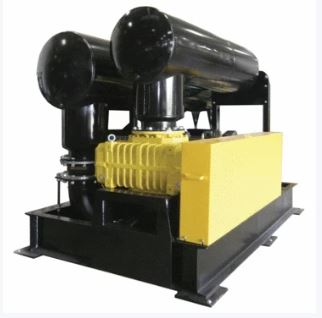Positive displacement (PD) blowers serve as highly efficient devices for various industrial processes including vacuum processing, conveying, blending, and aeration operations. These essential machines play a crucial role in multiple sectors such as chemical processing, dairy production, bulk material handling, oil & gas operations, and pulp & paper manufacturing. However, despite their indispensable nature in numerous manufacturing processes, PD blowers come with a significant challenge: their notably high noise levels. In this article, we’ll explore how PD blower silencers can help create a more sound-friendly environment in your facility.
Sources and Frequencies
During PD blower operation, noise emanates from three primary sources:
1. Air borne – generated by air pulsation through inlet and outlet points
2. Mechanical – produced by motor operation, gear movement, and impeller rotation
3. Vibration – resulting from pulsating air forces
Among these three noise sources, airborne noise emerges as the most significant concern, requiring primary attention for reduction. In certain instances, airborne noise can reach intensities exceeding 100 dBA.
The frequency of airborne noise is significantly influenced by how a PD blower’s operating speed relates to its transition speed. When PD blower functions below their transition speed, they produce low to mid-range frequency noise, while operation above transition speed results in higher frequency noise emissions. The frequency of airborne noise serves as a crucial factor in determining the most suitable noise reduction solution.
Silencer Types
 Silencers represent the most widely adopted solution for PD blower noise reduction. The selection of appropriate silencer type depends heavily on the blower’s operating speed and the generated noise frequencies. For PD blowers operating below transition speed and primarily producing low-frequency noise, simple chamber style silencers, also known as reactive silencers, prove most effective. These devices incorporate multiple expansion chambers and acoustically balanced bypass tubes for noise reduction. Like automotive mufflers, chamber silencers minimize noise through destructive interference.
Silencers represent the most widely adopted solution for PD blower noise reduction. The selection of appropriate silencer type depends heavily on the blower’s operating speed and the generated noise frequencies. For PD blowers operating below transition speed and primarily producing low-frequency noise, simple chamber style silencers, also known as reactive silencers, prove most effective. These devices incorporate multiple expansion chambers and acoustically balanced bypass tubes for noise reduction. Like automotive mufflers, chamber silencers minimize noise through destructive interference.
For PD blowers operating above transitional speed and generating high-frequency noise, an absorption-chamber style silencer offers the optimal solution. This type utilizes fiber-based absorption materials that reduce high-frequency noise through energy absorption.
However, certain applications, such as wastewater treatment facilities, prohibit the use of absorption materials for high-frequency noise reduction. In response to this challenge, Universal pioneered the three-chamber silencer, delivering high-frequency attenuation comparable to absorption-chamber style silencers.
Silencer Location
The airborne noise generated by a PD blower emanates from both the inlet and outlet points. For compact PD blowers, installing a combination filter/silencer at the inlet might provide adequate noise control. However, larger-scale blowers require separate filtering and silencing components to achieve maximum noise reduction efficiency. In vacuum applications, the jet inlet necessitates an additional silencer installation.
While PD blowers emit noise from multiple points, the outlet produces the most significant sound levels. The outlet silencer, however, serves a dual function in the system. Beyond minimizing airborne noise exposure for facility personnel working in proximity to the PD blower, it also effectively reduces air pressure fluctuations that would otherwise propagate through the piping network. Without proper silencing equipment, these pressure pulsations can fluctuate between 40% and 80% of the absolute line pressure, potentially causing severe damage to downstream equipment components.
Standard vs. Premium Silencers
The distinction between premium (or critical) and standard silencers often creates confusion. Premium silencers feature an enlarged chamber design, available in both chamber and absorption-chamber configurations. The expanded chamber dimensions enhance low-frequency noise attenuation through increased destructive interference capabilities.
Conclusion
If your facility faces challenges with excessive PD blower noise affecting employee comfort and safety, Eldridge stands ready to assist. Our team can conduct an on-site assessment of your noise concerns and propose tailored solutions designed to create a more comfortable working environment for your personnel.
